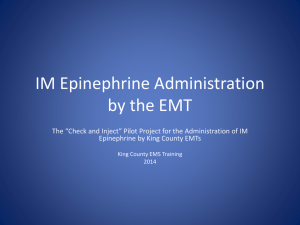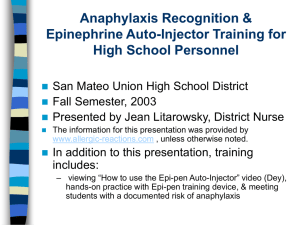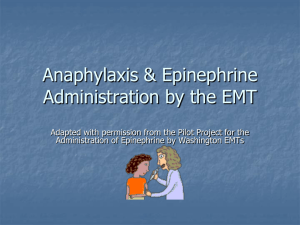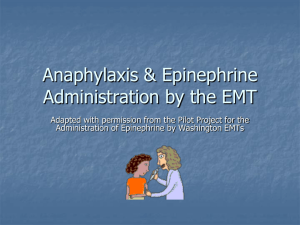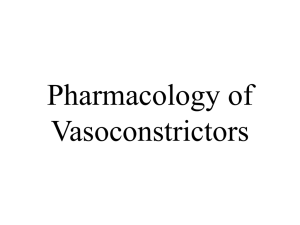Kjær Adrenal medulla
advertisement
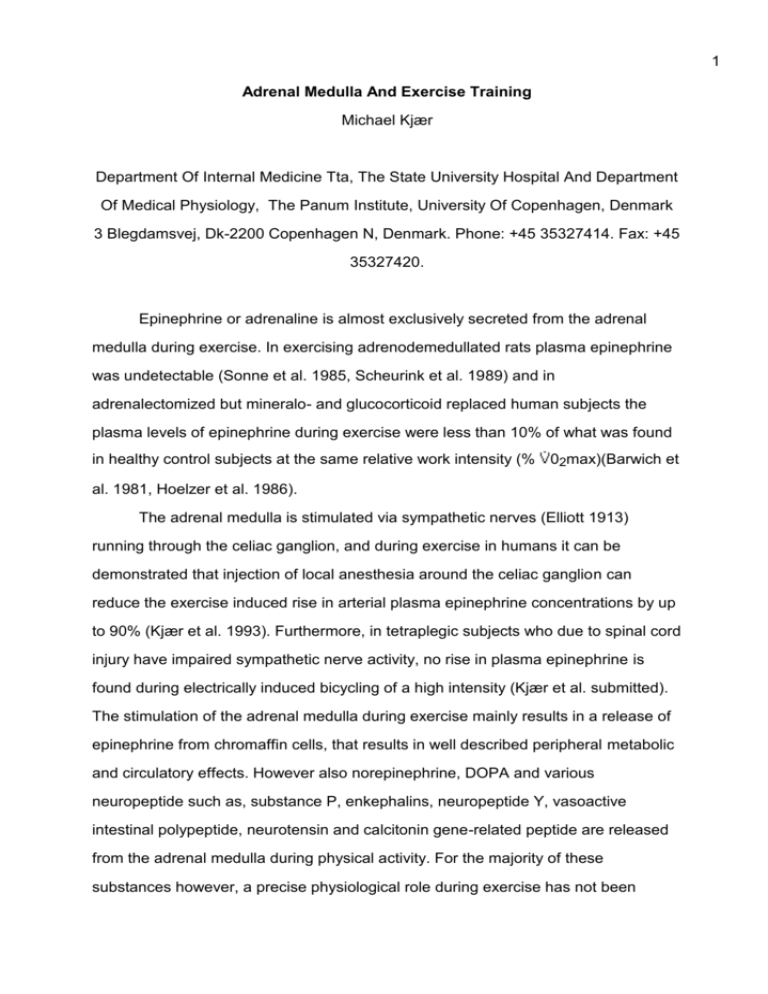
1 Adrenal Medulla And Exercise Training Michael Kjær Department Of Internal Medicine Tta, The State University Hospital And Department Of Medical Physiology, The Panum Institute, University Of Copenhagen, Denmark 3 Blegdamsvej, Dk-2200 Copenhagen N, Denmark. Phone: +45 35327414. Fax: +45 35327420. Epinephrine or adrenaline is almost exclusively secreted from the adrenal medulla during exercise. In exercising adrenodemedullated rats plasma epinephrine was undetectable (Sonne et al. 1985, Scheurink et al. 1989) and in adrenalectomized but mineralo- and glucocorticoid replaced human subjects the plasma levels of epinephrine during exercise were less than 10% of what was found in healthy control subjects at the same relative work intensity (% 02max)(Barwich et al. 1981, Hoelzer et al. 1986). The adrenal medulla is stimulated via sympathetic nerves (Elliott 1913) running through the celiac ganglion, and during exercise in humans it can be demonstrated that injection of local anesthesia around the celiac ganglion can reduce the exercise induced rise in arterial plasma epinephrine concentrations by up to 90% (Kjær et al. 1993). Furthermore, in tetraplegic subjects who due to spinal cord injury have impaired sympathetic nerve activity, no rise in plasma epinephrine is found during electrically induced bicycling of a high intensity (Kjær et al. submitted). The stimulation of the adrenal medulla during exercise mainly results in a release of epinephrine from chromaffin cells, that results in well described peripheral metabolic and circulatory effects. However also norepinephrine, DOPA and various neuropeptide such as, substance P, enkephalins, neuropeptide Y, vasoactive intestinal polypeptide, neurotensin and calcitonin gene-related peptide are released from the adrenal medulla during physical activity. For the majority of these substances however, a precise physiological role during exercise has not been 2 described, and the present review will therefore focus on epinephrine in relation to physical training. The Effect Of Training On Epinephrine Secretion During Exercise Arterial plasma concentrations of epinephrine rises markedly during exercise especially at high exercise intensities, the rise being less pronounced in endurance trained athletes (high maximal oxygen uptake) as compared to sedentary subjects at the same absolute work load (Fig 1)(Kjær et al 1988a, Deuster et al. 1989). This effect of training on the plasma epinephrine response occurs already over the first 35 weeks of training following the increase in maximal oxygen uptake (Winder et al. 1978), and the exercise-induced rise in plasma epinephrine is closely correlated to the relative work load (% of maximal oxygen uptake) in the individual. To evaluate whether changes in plasma epinephrine actually reflects changes in adrenal medullary secretion rates, turnover studies are important. When epinephrine clearance (3H-epinephrine infusion) is determined in both endurance athletes and in sedentary controls, a significant inverse relationship is found between clearance and exercise intensity expressed relative to individual maximal capacity (% 02max)(Fig 2)(Kjær et al. 1985). Although epinephrine clearance increases 15% at mild exercise and decreases 20% at heavy exercise (Fig 2), the important point is that these small changes cannot explain the five to tenfold increase in plasma epinephrine levels often seen during exercise (Kjær et al. 1985). Therefore changes in plasma epinephrine levels during exercise in man do reflect changes in adrenal medullary secretion of epinephrine. Furthermore, differences in epinephrine clearance cannot explain differences in plasma epinephrine between subjects with different training status. However, since clearance varies with the relative work load and therefore at a given work load might increase in trained (low % 02max) but decrease in untrained subjects (high % 02max) one may overestimate differences in epinephrine secretion between trained and untrained by only relying on plasma 3 concentrations (Kjær et al. 1985). The mechanism behind the lower epinephrine response in trained compared to untrained subjects when compared at identical absolute work loads (at a given 02) is probably a reduction in stimuli to increase the autonomic neuroendocrine activity during exercise. It has been shown that not only peripheral feed back (Sato et al. 1986), but also activity in motor centers in the brain can directly elicit autonomic neuroendocrine activity during exercise (Kjær et al. 1987). By the use of tubocurarine, skeletal muscles were weakened and the voluntary effort (and thereby the motor center activity) to perform a certain work output was increased, and this resulted in a larger epinephrine response compared to control experiments (Fig 3). When work load was reduced during curarization to achieve identical perceived exertion as compared to control (Fig 3, right part) identical epinephrine responses were found during exercise. Therefore a training status dependent change in perceived exertion in a given individual alters the stimulation of adrenomedullary secretory activity during exercise. Training-Induced Alterations In Secretory Capacity Of The Adrenal Medulla. The diminished epinephrine response to a given workload in athletes compared to untrained subjects may reflect that the signals influencing autonomic neuroendocrine activity are modified with physical training. However, this does not exclude adaptations in the tissue of the adrenal medulla leading to a change in the secretory capacity of the endocrine gland. At the end of prolonged exhausting exercise, the epinephrine concentration in arterial plasma as well as estimated epinephrine secretion were higher in athletes than in sedentary subjects (Kjær et al., 1985). This difference was probably not due to differences in stimuli in the two groups causing a higher nervous drive on the adrenal medulla in the trained subjects, because at exhaustion the relative work load 4 (% 02max), heart rate, plasma glucose concentration and hematocrit were identical in trained and untrained subjects (Kjær et al., 1985). In another study, an exercise protocol which aimed at identical stimulation of the adrenal medulla in trained and untrained subjects was used (Kjær et al., 1986). Catecholamine concentrations in arterialized blood were measured during graded exercise including work intensities above maximal oxygen uptake. Duration and relative intensity (% 02max) of the different stages were identical for athletes and untrained subjects and so were heart rates and norepinephrine concentrations. Nevertheless, epinephrine responses were markedly higher in the athletes than in the sedentary subjects. This pattern of epinephrine responses in trained vs untrained individuals was also found in studies where the adrenal medulla was specifically stimulated with various non-exercise stimuli (Yamaguchi 1992, Cheung 1990). In response to similar degrees of insulin-induced hypoglycemia (Kjær et a., 1984) as well as after stimulation with hypoxia (Kjær et al., 1988a, 1988b), hypercapnia (Kjær et al., 1988b), glucagon (Kjær et al., 1988b) or caffeine (LeBlanc et al. 1985) athletes had more pronounced increases in plasma epinephrine concentrations than untrained individuals. Although a full dose-response relationship between the various stimuli and epinephrine secretion was not obtained in these experiments, e.g. the exercise stimulus as well as the glucagon dose was close to maximal, and thereby reflected maximal epinephrine secretion capacity for those stimuli. Therefore, these findings support the hypothesis that long-term endurance trained athletes have an increased adrenal medullary secretory capacity. One study has however not been able to find a larger epinephrine response in trained subjects during hypoglycemia (Tremblay et al. 1990). This could be due to shorter training anamnesis in that study and due to the fact that subjects were studied early after a training bout, in a period were sensitivity to both epinephrine and insulin was markedly enlarged. This adaptation of the secretory capacity of the adrenal medulla probably requires a very long period of intense physical training. In short term training studies 5 in humans, it has not been possible to demonstrate any rise in adrenal medullary secretory capacity (Svendenhag 1985), and in highly trained athletes short-term (5 weeks) periods with inactivity due to an injury did not result in any significant alteration in the epinephrine response to hypoglycemia compared to the trained state (Kjær et al. 1992). The development of a "sports adrenal medulla" might be caused by the repeated stimulation of epinephrine secretion occurring with training. This higher secretion capacity may also be reflected by significant higher epinephrine levels in endurance athletes(Kjær et al. 1984,1985, 1986) although some studies have only found tendencies towards this (Lehmann et al. 1984, Svedenhag 1985). In one study performing 12-16 weeks intense bicycle training Devalon et al.(1989) actually found increased basal values of epinephrine as well as for DOPA, whereas basal levels of norepinephrine was unchanged. Finally, in a recent study the 24-hour release of epinephrine, defined as the total elevation over baseline values (during everyday activity including training sessions), was also found to be greater in well trained endurance athletes compared with sedentary controls (Dela et al. 1992). Adrenal Medullary Volume And Epinephrine Content After Physical Training The fact that short term alterations in level of physical activity does not bring foreword any change in epinephrine secretion capacity in humans, could speak in favor of a selection phenomenon (subjects with large epinephrine secretion capacity being more inclined to perform well in endurance sports) rather than a training induced adaptation. However, in 10-weeks swim training rats (up to 6 h daily) it has been demonstrated that not only the adrenal gland (Song et al. 1973, Östman et al., 1971) but also the adrenal medulla volume as well as the adrenal content of epinephrine was larger/higher in endurance trained young animals compared to control rats who were either weight matched, sham trained or cold stressed (Fig 5)(Stallknecht et al. 1990). The training induced enlargement of the adrenal medulla 6 was mainly a hypertrophy, and the increased epinephrine content was due to the enlargement of the gland rather than due to increased medullary epinephrine concentration (Stallknecht 1990, Schmidt et al. 1992). Therefore it is likely that in humans adrenal medulla adapts as a result of training, but that several years of training is required to bring foreword this adaptation. At present, it has not been possible to find methods (MRI etc.) that are accurate and precise enough to pick up possible anatomical differences in adrenal gland size between trained and untrained subjects (Stallknecht and Kjær, unpublished observations). Interestingly, the adaptations in rats were more pronounced in males compared to females, indicating gender differences (Stallknecht et al. 1990). Studies evaluating gender differences in adreno-medullary adaptation to training in humans have not been carried out. The hypertrophy of the adrenal medulla in response to training can also occur in old rats training on a treadmill for 10 weeks (Schmidt et al. 1992) indicating that endocrine tissue, as is the case for skeletal muscle, can adapt to physical training also at an older age (Hagberg et al. 1988). It has however to be noted that the adaptation of the adrenal medulla to training was markedly lower in the old compared to the young animals (Schmidt et al. 1992). In the young animals the training may have had a more pronounced influence on adreno-medullary function. As an example, Stallknecht et al (1990) found that the epinephrine response to hypoglycemia in the swim-training rats (with adrenal medulla hypertrophy) was markedly diminished. Probably the fact that the rats were hypoglycemic not only at the end of each exercise bout, but also between training sessions, caused adaptations within the central nervous system that are specifically related to a young age, and that are not found in humans with free access to food and less pronounced hypoglycemia. Conclusion Physical training induces at least three different adaptations of the adrenal 7 medulla. First, endurance training that increases 02max, results in a lower plasma epinephrine concentration at a given absolute submaximal exercise intensity, probably related to a diminished sympathetic innervation of the adrenal medulla. Secondly however, compared at identical relative work loads as well as in response to numerous non-exercise stimuli, athletes have a higher epinephrine secretion capacity compared to sedentary subjects, indicating that a long-term adaptation of endocrine glands to endurance training occurs - the development of a so-called "sports adrenal medulla". Thirdly, longitudinal studies in animals indicate that both adrenal medullary volume as well as adrenal epinephrine content increases as a result of long-term physical training (Fig 5). Since epinephrine has several advantageous effects on heart, skeletal muscle and the central nervous system in relation to exercise performance the higher capacity to secrete epinephrine in well-trained subjects is beneficial in competitive sports. Finally, taking into account that the secretion capacity for epinephrine decreases with age, physical training can cause a biological rejuvenation of the adrenal medulla similar to events taking place in heart and skeletal muscle. References: 1. Barwich, D., Hägele, H., Weiss, M., Weicker, H. Hormonal and metabolic adjustment in patients with central Cushing´s disease after adrenalectomy. Int. J. Sports Med. 2: 220-227, 1981. 2. Cheung, C.Y. Fetal adrenal medulla catecholamine response to hypoxia-direct and neural components. Am. J. Physiol. 258: R1340-R1346, 1990. 3. Dela, F., Mikines, K.J., Linstow, M.V., Galbo, H. Heart rate and plasma catecholamines during 24 h everyday life in trained and untrained men. J.Appl.Physiol. 73: 2389-2394, 1992. 4. Deuster, P.A., Chrousos, G.P., Luger, A., DeBolt, J.E., Trostmann, U.H., Kyle, 8 S.B., Montgomery, L.C., Loriaux, D.L. Hormonal and metabolic responses of untrained, moderately trained, and highly trained men to three exercise intensities. Metabolism 38: 141-148, 1989. 5. Devalon, M.L., Miller, T.D., Squires, R.W., Rogers, P.J., Bove, A.A., Tyce, G.M. Dopa in plasma increases during acute exercise and after exercise training. J. Lab. Clin. Med. 114: 321-327, 1989. 6. Elliott, T.R. The innervation of the adrenal glands. J. Physiol.(Lond.) 46: 285-290, 1913. 7. Hagberg, J.M., Seals, D.R., Yerg, J.E., Gavin, J., Gingerich, R., Premachandra, B., Holloszy, J.O. Metabolic responses to exercise in young and older athletes and sedentary men. J.Appl.Physiol. 65: 900-908, 1988. 8. Hoelzer, D.R., Dalsky, G.P., Schwartz, N.S., Clutter, W.E., Shah, S.D., Holloszy, J.O., Cryer, P.E. Epinephrine is not critical to prevention of hypoglycemia during exercise in humans. Am. J. Physiol. 251: E104-E110, 1986. 9. Kjær, M., Mikines, K.J., Christensen, N.J., Tronier, B., Vinten, J., Sonne, B., Richter, E.A., Galbo, H. Glucose turnover and hormonal changes during insulininduced hypoglycemia in trained humans. J.Appl.Physiol. 57: 21-27, 1984. 10. Kjær, M., Christensen, N.J., Sonne, B., Richter, E.A., Galbo, H. Effect of exercise on epinephrine turnover in trained and untrained male subjects. J.Appl.Physiol. 59: 1061-1067, 1985. 11. Kjær, M., Farrell, P.A., Christensen, N.J., Galbo, H. Increased epinephrine response and inaccurate glucoregulation in exercising athletes. J.Appl.Physiol. 61: 1693-1700, 1986. 12. Kjær, M., Secher, N.H., Bach, F.W., Galbo, H. Role of motor center activity for hormonal changes and substrate mobilization in exercising man. Am. J. Physiol. 253: R687-R695, 1987. 13. Kjær, M., Bangsbo, J., Lortie, G., Galbo, H. Hormonal response to exercise in man: influence of hypoxia and physical training. Am. J. Physiol. 254: R197-R203, 1988a. 9 14. Kjær, M, Galbo, H. Effect of physical training on the capacity to secrete epinephrine. J.Appl.Physiol. 64: 11-16, 1988b. 15. Kjær, M., Mikines, K.J., Linstow, M., Galbo, H., Nicolaisen, T. Effect of 5 weeks detraining on epinephrine response to insulin induced hypoglycemia in athletes. J. Appl.Physiol. 72: 1201-1204, 1992. 16. Kjær, M., Engfred, K., Fernandes, A., Secher, N.H., Galbo, H. Regulation of hepatic glucose production during exercise in humans: role of sympathoadrenergic activity. Am. J. Physiol. 265: E275-E283, 1993. 17. LeBlanc, J., Jobin, M., Cote, J., Samson, P., Labrie, A. Enhanced metabolic response to caffeine in exercise-trained human subjects. J.Appl.Physiol. 59: 832837, 1985. 18. Lehmann, M., Dickhuth, H.H., Schmid, P., Porzig, H., Keul, J. Plasma catecholamines, beta-adrenergic receptors and isoproterenol sensitivity in endurance trained and non-endurance-trained volunteers. Eur. J. Appl. Physiol. 52: 362-369, 1984. 19. Sato, A., Sato, Y., Schmidt, R.F. Catecholamine secretion and adrenal nerve activity in response to movements of normal and inflamed knee joints in cats. J. Physiol.(Lond.) 375: 611-624, 1986. 20. Schuerink, A.J.W., Steffens, A.B., Bouritius, H., Dreteler, G.H., Bruntink, R., Remie, R., Zaagsma, J. Adrenal and sympathetic catecholamines in exercising rats. Am. J. Physiol. 256: R155-R160, 1989. 21. Schmidt, K.N., Gosselin, L.E., Stanley, W.C. Endurance exercise training causes adrenal medullary hypertrophy in young and old Fischer 344 rats. Horm. Metab. Res. 24: 511-515, 1992. 22. Song, M.K., Ianuzzo, C.D., Saubert, C.W., Gollnick, P.D. The mode of adrenal gland enlargement in the rat in response to exercise training. Pflügers Arch. 339: 59-68, 1973. 23. Sonne, B., Mikines, K.J., Richter, E.A., Christensen, N.J., Galbo, H. Role of liver nerves and adrenal medulla in glucose turnover of running rats. J.Appl.Physiol. 10 59: 1640-1646, 1985. 24. Stallknecht, B., Kjær, M., Ploug, T., Maroun, L., Ohkuwa, T., Vinten, J., Mikines, K.J., Galbo, H. Diminished epinephrine response to hypoglycemia despite enlarged adrenal medulla in trained rats. Am. J. Physiol. 259: R998-R1003, 1990. 25. Svedenhag, J. The sympatho-adrenal system in physical conditioning. Acta Physiol. Scand. 125,suppl.543: 1-74, 1985. 26. Tremblay, A., Pinsard, D., Coveney, S., Catellier, C., Laferriere, G., Richard, D., Nadeau, A. Counterregulatory response to insulin-induced hypoglycemia in trained and nontrained humans. Metabolism 39: 1138-1143, 1990. 27. Winder, W.W., Hagberg, J.M., Hickson, R.C., Ehsani, A.A., McLane, J.A. Time course of sympathoadrenal adaptation to endurance training in man. J.Appl.Physiol. 45: 370-374, 1978. 28. Östman, J., Sjöstrand, N.O. Effect of heavy physical training on the catecholamine levels of the heart and the adrenals of the rat. Acta Physiol. Scand. 82: 202-208, 1971. 29. Yamaguchi, N. Sympathoadrenal system in neuroendocrine control of glucose: mechanisms involved in the liver, pancreas, and adrenal gland under hemorrhagic and hypoglycemic stress. Can. J. Physiol. Pharmacol. 70: 167-206, 1992. Legends To Figures: Fig 1. Epinephrine concentrations in arterial plasma during bicycle exercise (210 W) in 7 endurance trained and 7 sedentary control males. Means and SE are given. Modified from Kjær et al. 1988a. Fig 2. Epinephrine clearance at rest and exhausting bicycle exercise in 6 endurance trained athletes and 6 untrained subjects. The exercise intensity is expressed relative 11 to individual maximal oxygen uptake and epinephrine clearance determined by tracer infusion. At rest clearance was identical in the two groups (28.8 ml/kg/min). Individual values during exercise are given as % of individual resting values. Modified from Kjær et al. 1985. Fig 3. Epinephrine concentration in arterial plasma at rest and during 2 exercise periods. 8 subjects were studied with and without partial neuromuscular blockade with tubocurarine. The value 8 (5-13) min before start of exercise represents a sample taken immediately before drug administration. Values are mean and SE. Star and triangle denotes difference (p<0.05 and p<0.01, respectively) between curare and control experiments. Modified from Kjær et al. 1987. Fig 4. The adrenal medulla volume in response to 10 weeks of swim training in rats. Means and SE are given. Stars denote difference (p<0.05) between swim training group and control experiments. Modified from Stallknecht et al 1990. Fig 5. no text

